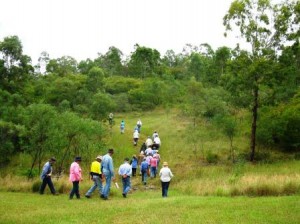Field Day March 2015
The HFFN field day in March 2015 provided an opportunity to see what Simon and Bronwyn plan to do on their recently purchased land – 90 acres of Lower Hunter Valley Dry Sclerophyll forest. In the long term they hope to be able to log timber as well as grow olives, pine nuts and truffles.
The tree species included ironbark (some large), spotted gum, grey box, black wattle and a lone tallow wood. Areas which had previously been cleared for cattle are now showing significant re-vegetation and a concern was how to manage this new growth so as to produce straight, valuable trees. Where the trunk is more than 8 inches in diameter, Simon has removed the side branches. He was advised not to thin out the competing trees yet but to allow these neighbouring trees to stay awhile so as to encourage straight growth in the large canopy tree.
The day began with a tribute to Ian Painter who was an active member until his death in 2014. Ian’s wife, Jennifer attended the field day. She recalled that Ian always said that at the field days he always learnt something new.
A general meeting held after lunch and brainstormed future field days: it was suggested that a course ‘An Introduction to Farm Forestry’ be held on May 24th and June 21st 2015.
Members inspecting the property with Simon on a logged iron bark discussing the layout


